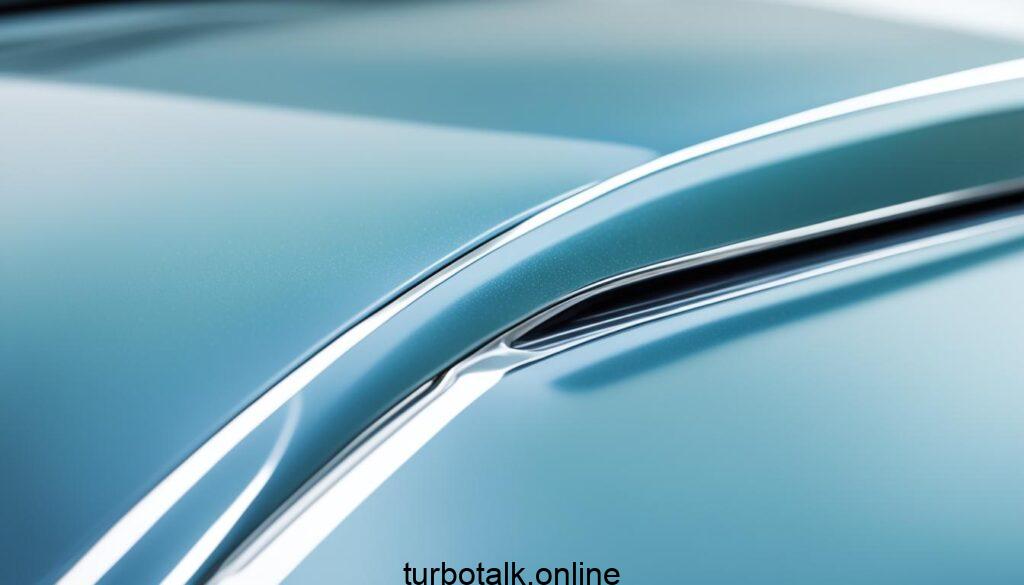As you drive through the city, have you ever thought about what’s under your car’s shiny surface? The future of car making is changing fast, thanks to nanotechnology. This field works with tiny things like atoms and molecules.
Nanotechnology is changing how we make cars and how they work. It makes parts lighter and stronger, and it helps cars last longer. It also makes them resistant to scratches and improves how they use energy.

We’re going to look at how nanotechnology is changing the car industry. It’s making driving better, saving fuel, and making cars safer. These are the things that matter to you, the car buyer.
Introduction to Nanotechnology in the Automotive Industry
Nanotechnology is changing the game in the car industry. It’s making vehicles better in many ways. By using tiny materials, car makers can improve how cars work, use less fuel, and be kinder to the planet.
Definition and Scope of Nanotechnology
Nanotechnology is all about working with materials that are small. These materials are between 1 and 100 nanometers big. They can act differently than bigger materials, which opens up new possibilities. The car industry is fast to see the benefits of this tech, using it in many parts of a car.
Nanotechnology’s Unique Properties and Applications
- Nanomaterials for automotive applications make cars stronger, lighter, and more fuel-efficient.
- Nanocoatings for car surface protection help cars stay scratch-free and clean themselves, and they move through the air better.
- Nanoparticles in lubricants make engines run smoother and last longer, saving fuel.
- Nano-enhanced batteries for electric vehicles hold more charge, charge up quicker, and last longer, making electric cars more useful.
- Nanofibers for lightweight automotive components help make cars lighter without losing strength.
- Nanosensors for vehicle monitoring give real-time info on how a car is doing, helping with maintenance and making it run better.
Nanotechnology is changing the car industry in big ways. It’s leading to new ideas and making cars better in many areas.
Lightweight Materials for Automotive Parts and Bodies
Nanotechnology has changed the game in car engineering by making car parts lighter. By making cars lighter, they become safer and use less fuel. Carbon nanotubes (CNTs) and clay nanocomposites are great because they’re strong yet light.
These materials also handle heat well, which is important for cars. Thanks to nanomaterials, cars are 70% quieter, 20% stronger, 30% better at handling heat, and use less fuel.
Enhancing Strength and Thermal Properties
Ford is leading the way in using these new materials in cars. They’ve used graphene nanocomposites in the Mustang and F-150, making them stronger. These materials also help cars use fuel better, reduce friction, and make less noise. This means cars are better for the planet.
Companies like Goodfellow offer nanocomposites for automotive components and nanomaterials in automotive coatings. They have things like gold nanoparticles, graphene, and multi-walled carbon nanotubes. These help cars use less fuel and make parts stronger.

Nanoceramics for engine components and nanostructured catalysts for emissions reduction have made a big difference. They improve how cars burn fuel, cut down on emissions, and make engines run better. Nano-engineered catalysts also make car parts last longer and work better.
Nanocoatings for Scratch and Wear Resistance
Nanotechnology is changing the car industry in big ways. One big change is the use of nanocoatings. These coatings make car parts better by adding scratch and wear resistance.
Nanoparticles in polymer coatings make car parts better. For example, adding nano-SiO2 makes them more scratch-resistant. Other particles like SiC, ZrO2, ZnO, Al2O3, and TiO2 also help in different ways.
The secret to these coatings is the tiny size of the particles. They have a big surface area that changes the material’s stiffness and elasticity. This makes new, lighter materials that can replace heavy metals in cars, helping with automotive lightweighting.
These particles can also be made to repel water, which helps them stick better to the polymer. This is key for making car coatings last longer and stay strong against scratches and wear.
The size, shape, and chemical makeup of the nanoparticles matter a lot. They make car clearcoats more resistant to scratches. This means cars can have nanoparticle-reinforced tires, nano-engineered engine components, and other nanomaterials for vehicles that last longer and take more damage.

Nanotechnology for Mirrors, Windows, and Anti-Glare Surfaces
Nanotechnology has changed the car industry in big ways. It has made our vehicles better in many ways. Now, we see new tech in mirrors, windows, and anti-glare surfaces thanks to nanotech.
This tech uses tiny materials to make cars safer and work better. It’s a big step forward for car safety and performance.
Thin-film coatings and Chemical Vapor Deposition
Thin-film coatings, just a few nanometers thick, are now common in cars. They’re made using chemical vapor deposition (CVD). These coatings make mirrors and windows reflect light better, reducing glare from the sun and other cars.
This makes driving safer and more comfortable. It helps drivers see better and feel more secure on the road.
Hydrophobic and Oleophobic Nanocoatings
Nanotech has also led to hydrophobic and oleophobic coatings for cars. These coatings keep mirrors and windows clean by repelling water and oil. They use a thin layer of aluminum oxide (Al2O3) made by CVD.
This keeps windows clear and prevents fogging. It makes driving safer and clearer in all weather.
Nanotech has made car mirrors, windows, and anti-glare surfaces better. It’s changed how cars work and how safe they are. This tech makes cars last longer and works better.
Impact of Nanotechnology on Car Manufacturing and Performance
Nanotechnology has changed the game in the car industry. It brings new ways to make cars better, use less fuel, and be safer. By using nanomaterials, car makers can now make nanotech for energy-efficient vehicles, nanotech for improved safety features, and nanotechnology for enhanced performance.
Improving Fuel Efficiency and Reducing Emissions
Nanotechnology helps make nanocomposites in the automotive industry that are both light and strong. By adding nanomaterials for automotive applications like carbon nanotubes, cars can be made lighter. This means they use less fuel and emit less pollution.
Enhancing Safety and Durability
Nanotech also makes cars safer and more durable. Nanocoatings give cars a layer that resists scratches and wear, making parts last longer. Plus, nanomaterials in tires and batteries make cars safer and more stable.
Using nanotechnology in cars offers big benefits for performance, fuel use, the environment, and safety. As this tech gets better, we’ll see more ways to use nanotech for energy-efficient vehicles, nanotech for improved safety features, and nanotechnology for enhanced performance.
| Nanotechnology Application | Key Benefits |
|---|---|
| Lightweight Nanocomposites | Improved fuel efficiency and reduced emissions |
| Nanocoatings for Scratch and Wear Resistance | Enhanced durability and long-term performance |
| Nanoparticles in Tires and Batteries | Improved safety, stability, and vehicle longevity |
Nanoparticles in Tires for Improved Wear Resistance
The automotive industry is always finding new ways to innovate. Nanoparticle-reinforced tires are a big step forward. They make tires last longer and perform better by adding nanoparticles to the rubber.
Adding aluminum oxide (Al2O3) nanoparticles to tire rubber greatly improves wear resistance. This can make tires last up to 800% longer. It’s a big deal for tire makers.
Using carbon black in tire rubber also boosts wear resistance. This makes tires more reliable and long-lasting. With more cars on the road, durable tires are key to reducing waste and saving resources.
| Nanomaterial | Improvement in Tire Properties |
|---|---|
| Al2O3 Nanoparticles | Wear resistance improved by up to 800% |
| Carbon Black (60 phr) | Significant improvement in wear resistance |
| Silicon Dioxide (10%) and Multi-Wall Carbon Nanotubes (3%) | Tensile strength increased by 600%, tear strength increased by 250%, and hardness increased by 70% |
| Silicon Dioxide (10%) and Montmorillonite Clay (3%) | Provided isotropic behavior, improved longitudinal and lateral performance, and maintained a good trade-off between handling and comfort |
Nanoparticles in tires make them safer and last longer. They also help solve the big problem of tire waste. With more cars on the road, these innovations are crucial for a greener future.
Nanotechnology in Fuel Cells and Batteries
Vehicles are now depending more on advanced tech for energy. Nanotechnology is changing the game with new solutions for batteries and fuel cells.
Reducing Platinum Usage with Nanoparticles
Platinum has been a big problem in making fuel cells. It’s rare and expensive, making electric cars hard to afford. But, nanotech is changing this by using tiny amounts of platinum or other metals. This makes fuel cells cheaper and electric cars more accessible.
Lightweight and Long-Lasting Batteries
Nanotech is also changing battery design for electric cars. Using nanofibers and nanocomposites, batteries can be thinner and lighter without losing power. These new techs improve nano-enhanced fuel efficiency and nanoparticle emission control. This means electric cars can go farther and last longer, helping us move towards green transport.
Nanotech is making a big difference in fuel cells and batteries. From nanolubricants for friction reduction to nanocomposites for vehicles, these new technologies are leading us to a future of efficient and green transport.
Conclusion
Nanotechnology is bringing new excitement to the car industry. It aims to make cars more efficient, safe, and eco-friendly. By using nanocomposites for vehicle components, nano-enabled coatings for cars, and improving fuel cell technology and tire wear resistance, cars can become better.
Using nanostructured materials for lightweight vehicles and nanomaterials for enhanced safety could change the game. Nanotechnology for fuel efficiency and nanotechnology for electric vehicles are also key areas. But, it’s important to manage and regulate these new technologies well to protect the environment and health.
Overall, nanotechnology is set to bring big changes to the car industry. It will make cars perform better, use less fuel, and be kinder to the planet. This could lead to a future where cars are more innovative and eco-friendly.
FAQ About Impact of Nanotechnology on Car Manufacturing
What are the key applications of nanotechnology in the automotive industry?
Nanotechnology is changing the car world in big ways. It helps make car parts and bodies lighter. It also creates coatings that resist scratches and wear, fight corrosion, and boost fuel cell tech. Plus, it makes tires last longer.
How can nanotechnology improve vehicle efficiency and reduce emissions?
Nanotech makes cars more efficient and cuts down on pollution. It uses lightweight materials to reduce weight and save fuel. Plus, nanocoatings and nanoparticles in fuels and lubricants enhance engine performance and lower emissions.
What are the benefits of using nanocoatings in automotive applications?
Nanocoatings offer many advantages for cars. They make parts more resistant to scratches and wear. They also make surfaces like mirrors and windows hydrophobic and oleophobic, improving comfort and safety.
How can nanotechnology improve the safety and durability of automotive tires?
Nanoparticles in tire rubber boost safety and durability. They help tires wear out less and last longer. This reduces the environmental impact of tire waste. Studies show tires can last up to 800% longer with the right nanomaterials.
How can nanotechnology address the challenges of energy storage in electric vehicles?
Nanotech is solving energy storage issues in electric cars. It reduces the need for expensive platinum in batteries. This makes electric cars more affordable. Nanotechnologies also help create thinner, lighter, and longer-lasting batteries.
You might also like

